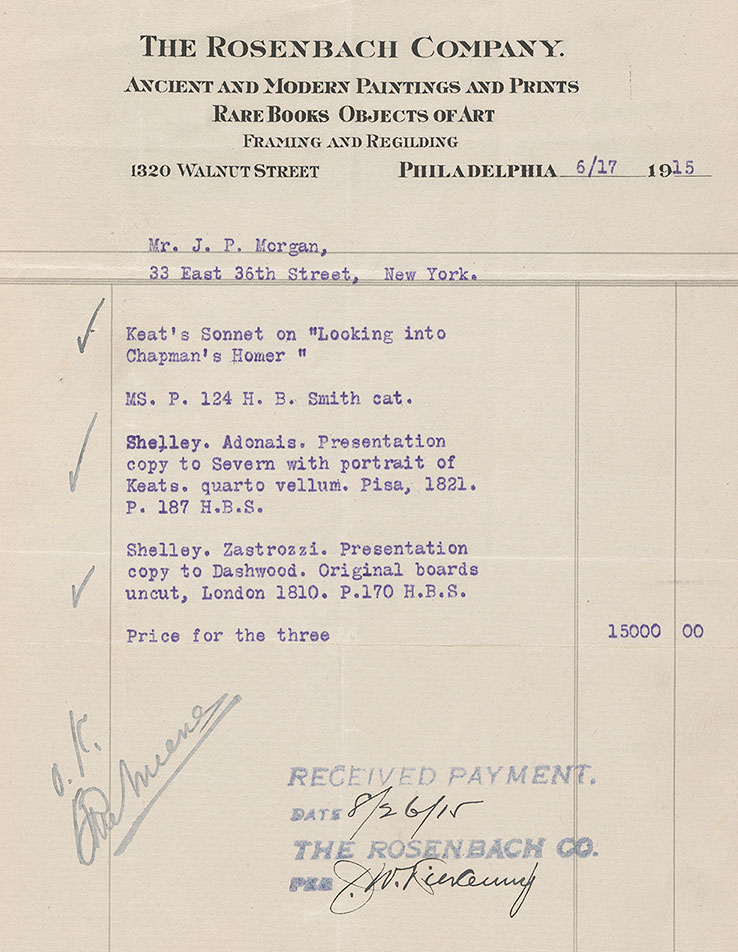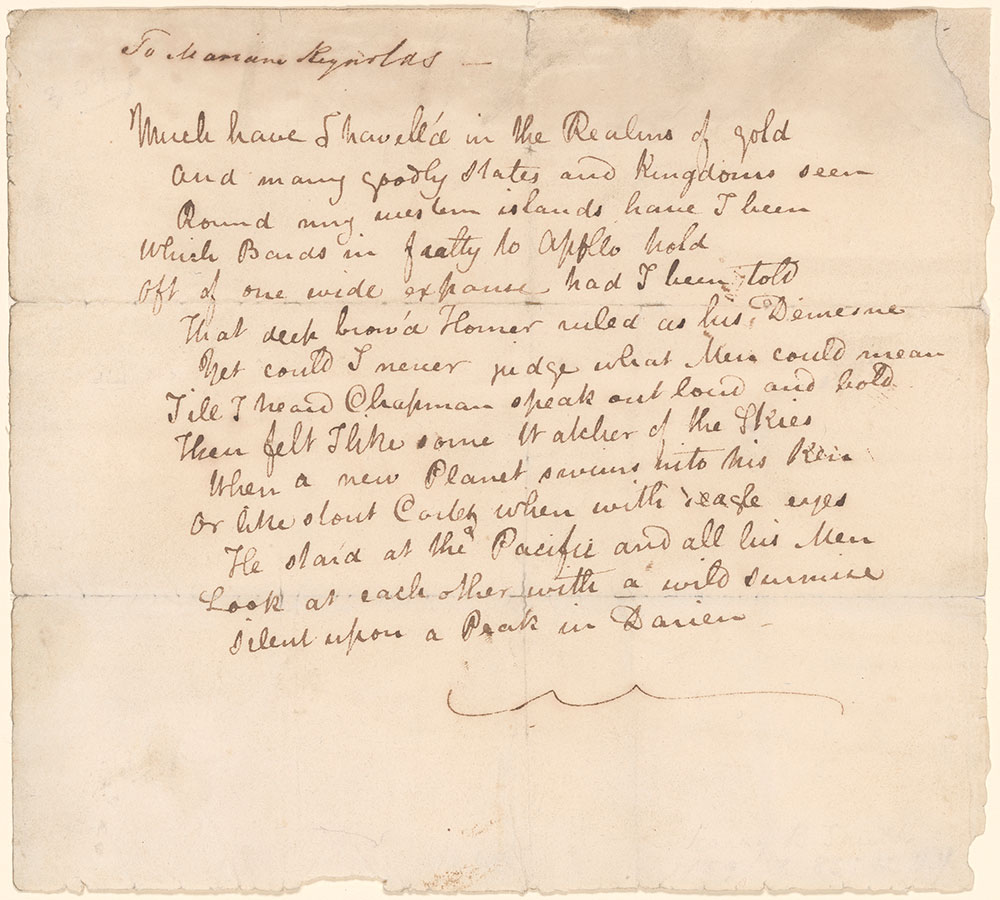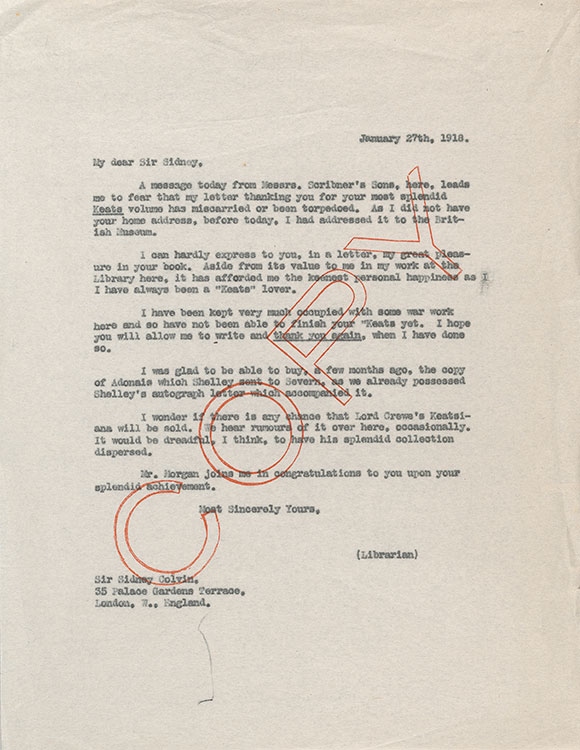Building the Morgan's Keats collection

After J. Pierpont Morgan’s death in 1913, Greene continued to make major acquisitions on behalf of his son and heir, J. P. Morgan, Jr. In the summer of 1915 she purchased two important Keats items from the Philadelphia bookseller A. S. W. Rosenbach (1876–1952): an early manuscript of Keats’s sonnet “On First Looking into Chapman’s Homer” and the copy of Shelley’s Adonais given to Joseph Severn. The surviving invoice shows that she paid $15,000 for these two items as well a copy of Shelley’s Zastrozzi.
“On First Looking into Chapman’s Homer” is the most celebrated of Keats’s early poems, composed and published in the fall of 1816. The story goes that Keats and his friend Charles Cowden Clarke (1787–1877) stayed up all night reading George Chapman’s translation of Homer’s Iliad and Odyssey (1616). The next morning Keats rapidly composed a sonnet on his transformative reading experience, likening it to the discovery of new planets or Europeans’ first glimpse at the Pacific Ocean’s eastern shore. After finishing the poem he promptly sent it back to Clarke, who was able to read it while eating breakfast.
Though scholars have long thought that the manuscript preserved at Harvard University’s Houghton Library is the original sent to Clarke, recent work has convincingly shown that the Harvard manuscript was sent instead to Joseph Severn; the original manuscript sent to Clarke, it seems, is now lost. The Morgan manuscript of “On First Looking into Chapman’s Homer” is in Keats’s hand and was given to his friend John Hamilton Reynolds (1794–1852), who later inscribed it to his sister, “To Mariane Reynolds.” We can date the text of the Morgan manuscript as later than the Harvard copy, but earlier than the authoritative version published in Keats’s 1817 Poems. The Morgan manuscript’s “Yet could I never judge what Men could mean” in line 7 would become “Yet never did I breathe its pure serene” in the 1817 Poems, while the Harvard manuscript’s “wond’ring eyes” becomes “eagle eyes” in the Morgan copy (and “eagle eyes” would remain in later versions).
Invoice from The Rosenbach Company, 17 June 1915. ARC 1310. Archives of the Morgan Library & Museum.
On First Looking into Chapman's Homer

John Keats, “On Looking into Chapman’s Homer,” autograph manuscript, 1816. MA 214.3. Purchased by Belle da Costa Greene on behalf of J. P. Morgan, Jr., 1915.
To Mariane Reynolds —
Much have I travell’d in the Realms of gold
And many goodly states and kingdoms seen
Round many western islands have I been
Which Bards in featly to Apollo hold
Oft of one wide expanse had I been told
That deep brow’d Homer rules as his Demesne
Yet could I never judge what Men could mean
Till I heard Chapman speak out loud and bold
Then felt I like one Watcher of the Skies
When a new Planet swims into his Ken
Or like stout Cortez when with eagle eyes
He star’d at the Pacific and all his men
Look at each other with a wild surmise
Silent upon a Peak in Darien.
Belle da Costa Greene letter to Sidney Colvin

Though we do not have any commentary from Belle Greene about “On First Looking into Chapman’s Homer,” she does mention her purchase of Severn’s copy of Adonais. In a letter to Sidney Colvin offering congratulations for his 1917 Keats biography, Greene describes herself as a “'Keats' lover” and mentions purchasing Severn’s Adonais: “I was glad to be able to buy, a few months ago, the copy of Adonais which Shelley sent to Severn, as we already possessed Shelley’s autograph letter which accompanied it.” Greene’s acquisition effectively reunited the two objects, showing once again her deep knowledge of the collection and keen sense for how to develop its various strengths.
Of course, there were Keats manuscripts Greene was not able to secure for the Library. J. Pierpont Morgan declined a set of letters offered in 1911 by the bookseller George H. Richmond; in a letter to A.J. Bowden, her contact at the firm, Greene expressed her disappointment that they were unable to make the acquisition: “I rather regret this, as I hoped we would wish to have them.” Again in 1912 Morgan declined a Keats letter, written to his brothers George and Tom in 1818, this time offered by the Minneapolis bookdealer Edmund D. Brooks. In her letter declining the offer Greene wrote, “I regret to say that Mr. Morgan is at present in a state of mind where he refuses to buy anything, and, for that reason, I cannot consider the purchase of your Keats letter. I think it extremely interesting and am sorry I cannot add it to this collection.”
But in other instances Greene and Morgan worked in lockstep, as in the case of their relationship with the writer and collector Annie Fields (1834–1915). Widow of the prominent publisher James T. Fields (1817–1881) and an important supporter of women writers in Boston, Annie Fields struck up a friendship with Belle Greene and Morgan and eventually offered her album of autograph poetry to the Library in 1909. In a 1910 letter Greene assures Fields that her “Book of Manuscripts … will have the place d’honneur in this Library, which I trust will last for all time.” The album included a fragment of Keats’s long narrative poem "Hyperion", the rest of which is held at the British Library.
Belle da Costa Greene, retained copy of typed letter to Sidney Colvin, 27 January 1918. ARC 1310. Archives of the Morgan Library & Museum.